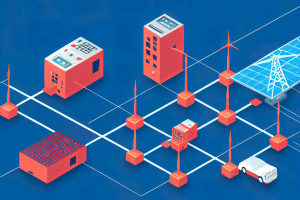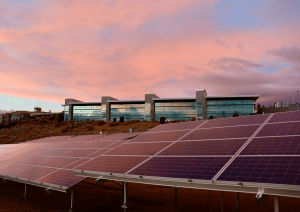Energy needs are continuously evolving, and microgrids offer a sustainable and reliable solution, providing flexibility and increased energy security. Sol-Ark® hybrid inverters play a crucial role in these systems, especially in enhancing the efficiency of both residential and commercial microgrids.
 The Basics: What is a Microgrid?
The Basics: What is a Microgrid?
A microgrid is essentially a small-scale power grid that can function independently or alongside the main electrical grid. It is designed to provide power to a limited area such as a neighborhood, a university campus, or a business complex. One of the key benefits of a microgrid is its ability to continue operating even when the main power grid goes down, ensuring a constant energy supply for homes and businesses and enhancing the overall resilience of the energy system.
Microgrids typically incorporate a variety of power sources, including renewable energy sources like solar panels, wind turbines, hydrogen fuel cells, and battery energy storage systems. These diverse energy sources make microgrids highly adaptable, support energy sustainability, and drive decarbonization goals for businesses and homes.
Hybrid Inverters: Central to Strong, Sustainable Microgrids
Hybrid inverters, such as the Sol-Ark® Whole Home and 60K-3P-480V, manage energy from both renewable sources and storage systems to provide a stable and efficient power supply while also strengthening microgrids.
Solar Energy Conversion
This is a crucial area in the operation of microgrids, where hybrid inverters convert direct current (DC) from solar panels into alternating current (AC), usable by home appliances and for commercial power needs.
Smart Energy Management
Hybrid inverters manage the flow of energy based on three main factors: immediate consumption, energy storage, and selling energy back to the grid. Because energy demands can vary significantly throughout the day for both businesses and homes, it’s critical to maximize the use of solar energy and reduce reliance on the main grid to lower electricity costs.
For example, you can adjust the time-of-use (TOU) settings on your hybrid inverter during peak sunlight hours. When solar panels produce excess electricity, this surplus energy is stored in batteries. Later, as the sun sets and solar panel production decreases, the stored battery energy can be released to meet the community’s power needs. This not only supports the grid during high demand periods but can also earn credits or income for the energy supplied, depending on local regulations and grid policies.
Grid Stability and Energy Security
Particularly in residential areas, hybrid inverters contribute to main power grid stability by managing excess production and supporting the main grid during high-demand periods. Microgrids with hybrid inverters enhance the stability and reliability of the broader power network. By enabling energy storage and independent operation, hybrid inverters contribute to the overall security of energy supply within a microgrid. This is particularly valuable in areas prone to outages or with unreliable main grid connections.
 Microgrids Create Reliability, Resilience, and Continuity for Businesses
Microgrids Create Reliability, Resilience, and Continuity for Businesses
Microgrids play a pivotal role in helping commercial and industrial businesses create energy resilience and reliability. For businesses and industries like data centers, hospitals, and manufacturing plants that require a constant, uninterrupted power supply (UPS), hybrid inverters are critical in ensuring this happens.
Main Grid Power Outage Detection
Hybrid inverters constantly monitor the status of the main power grid, detecting any interruptions or failures. This critical function helps trigger the system to switch to an alternative energy source (batteries or other renewable sources) before the outage can affect business operations.
Seamless Energy Source Transition
Once a main grid power failure is detected, the inverter immediately switches to battery-stored energy or other connected renewable sources such as wind, hydrogen fuel cells, or backup generators. This transition happens in real-time, ensuring there isn’t even a single second of lost power to critical functions or operations, thus creating a true uninterrupted power supply.
Business Continuity
By enhancing the reliability and resilience of power supplies, hybrid inverters directly support broader business continuity plans through energy cost management, as well as decarbonization and sustainability.
Microgrids equipped with hybrid inverters represent a leap forward in our approach to energy management. For homeowners, they offer energy independence, security, and lower energy bills. For businesses, they ensure continuity, sustainability, and profitability. As we move towards a more decentralized and renewable energy system, microgrids stand out as a smart, flexible, and resilient energy solution that empowers communities and businesses alike.

 The Basics: What is a Microgrid?
The Basics: What is a Microgrid?
 Microgrids Create Reliability, Resilience, and Continuity for Businesses
Microgrids Create Reliability, Resilience, and Continuity for Businesses

